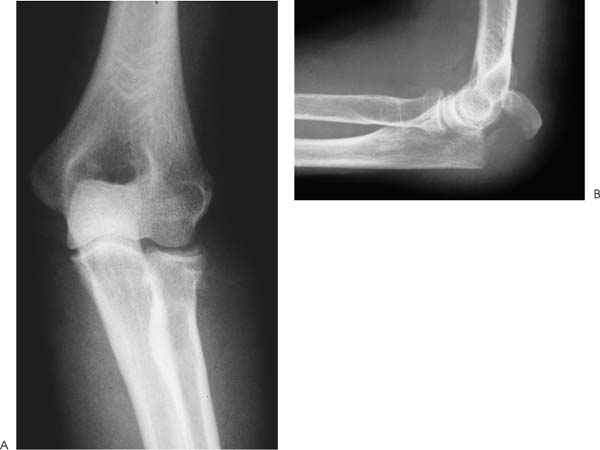Case 37 A 45-year-old right-hand-dominant factory worker tripped on an electrical cord several hours prior to admission and fell directly onto his flexed elbow. He reports the inability to actively extend his elbow. He also complains of significant posterior elbow pain and crepitation. Moderate swelling and pain to palpation are present in the posterior elbow. He does have minimal active triceps strength, but has passive range of motion of the elbow of 30 to 120 degrees. Figure 37–1. Anteroposterior (AP) (A) and lateral (B) radio-graphs of the elbow. 1. Triceps avulsion 2. Olecranon fracture 3. Elbow dislocation 4. Elbow contusion • Backing the K-wires out several millimeters prior to cutting, bending, and tapping them deep within the triceps tendon serves to minimize their prominence at their distal tip around the vital neurovascular structures. • Final tightening of the wire with the elbow near extension serves to enhance the tension band effect at the fracture site. • If plate and screw placement is required because of fracture orientation or comminution, lateral plate placement should be considered. It offers a lower profile and may allow for better bicortical fixation of the proximal fragment. PITFALL • Minimizing the prominence of hardware is imperative to reducing the chances for the necessity of hardware removal. Prominent hardware can even lead to skin breakdown and infection. Anteroposterior (AP) and lateral radiographs of the elbow are obtained (Fig. 37–1). Displaced Olecranon Fracture. The inability of the patient to actively extend his elbow in conjunction with the swelling and pain posteriorly suggests a displaced olecranon fracture. Radiographs confirm the fracture. Diagnosis is relatively straightforward and not easily confused with other pathologies once radiographs are obtained. Careful evaluation of the radiographs, however, is important in deciding on the best form of surgical repair. Olecranon fractures are not uncommonly associated with other elbow fractures including radial head fractures. Likewise, ligamentous disruptions of the medial ulnar collateral ligament and/or the lateral collateral ligament complex can occur as well. Significant ligamentous disruptions with certain olecranon fracture patterns can allow for subluxation of the ulnohumeral articulation, greatly complicating treatment. Failure to identify ulnohumeral subluxation can lead to significantly reduced functional improvement.
History and Physical Examination
Differential Diagnosis
Radiologic Findings
Diagnosis
Surgical Management
Stay updated, free articles. Join our Telegram channel

Full access? Get Clinical Tree









